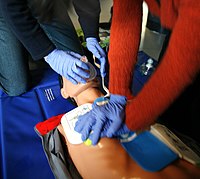
Photo from wikipedia
OBJECTIVE To analyse the differences in the quality of the basic cardiopulmonary resuscitation (CPR) between the algorithms of compressions with rescue ventilation (CPR [30:2]) and chest compressions only (CPR [C/O]).… Click to show full abstract
OBJECTIVE To analyse the differences in the quality of the basic cardiopulmonary resuscitation (CPR) between the algorithms of compressions with rescue ventilation (CPR [30:2]) and chest compressions only (CPR [C/O]). In addition, the specific objective was to study the effectiveness of the physical manoeuvre of mouth-to-mouth ventilations performed by nursing students after the completion of a simulation training program in Basic Life Support (BLS) standardized in the study plan approved for the Nursing Degree at a Spanish university. RESEARCH METHODOLOGY analytical, quasi-experimental, cross-sectional study with clinical simulation of 114 students enrolled in the third year of the Nursing Degree. RESULTS the mean depth of chest compressions was 47.6 mm (SD 9.5) for CPR [30:2] and 45 mm (SD 8.8) when CPR [C/O] was performed (t = 5.39, p < 0.0001, CI95% 1.69-3.65). The compressions with complete chest re-expansion were 106 (SD 55) for CPR [30:2] and 138 (SD 85) for CPR [C/O] [t = -4.75, p < 0.0001, CI95% -44.6 - (-18.4)]. Of the participants, 28.1% correctly ventilated with the head-tilt/chin-lift manoeuvre (Fisher: p < 0.0001). CONCLUSIONS As a whole, CPR with only chest compressions offers great advantages with respect to standard CPR, minimizing interruptions in compressions, maintaining coronary and cerebral perfusion and thus increasing the likelihood of return of spontaneous circulation. The problem of rescuers fatigue could be reduced with a greater number of relays between rescuers. We believe that is important to improve the acquisition of competencies in the management of the airway and the ventilation devices (such as the bag-valve mask).
Journal Title: International emergency nursing
Year Published: 2020
Link to full text (if available)
Share on Social Media: Sign Up to like & get
recommendations!